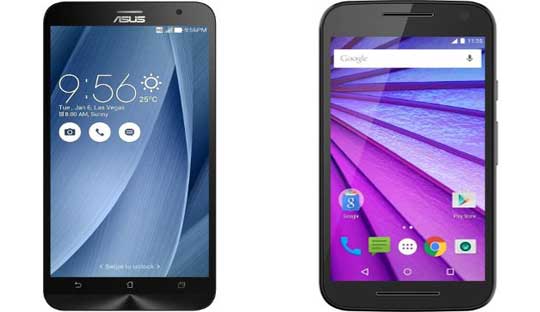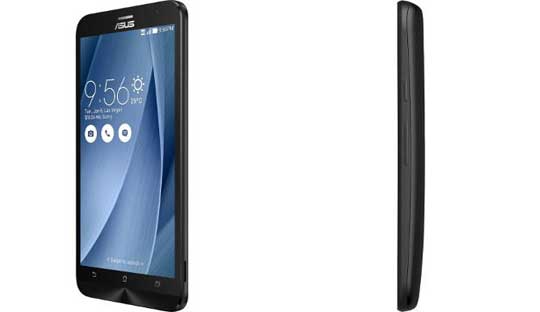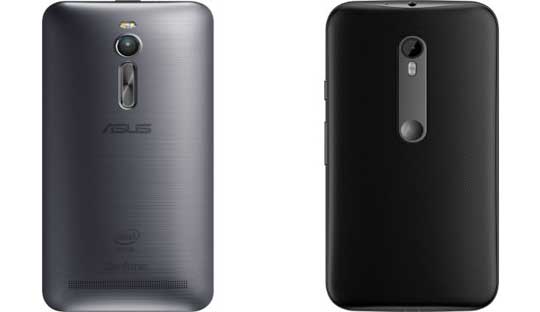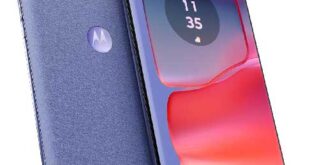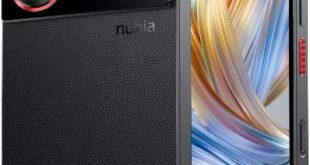In the mid-range arena, renowned smartphone makers have been launching an exciting range of devices at tempting price tags. From Samsung to Lenovo, almost every smartphone manufacturer has targeted the budget segment by offering powerful and well-crafted smartphones.
Recently, Motorola unveiled the Motorola Moto G 3rd Generation smartphone with some new and upgraded features when compared to the Moto G 2nd Generation. The device has hit the shelves and on the other side, the high-end model of this phone has been compared with Asus’ leading budget player, ZenFone 2. Both of these phones pack a nice set of features and go head to head in terms of RAM and display qualities. Motorola is one of the strongest players in the smartphone industry might just create some serious problems for Asus’s best-selling budget smartphone. To know more about major positives and negatives of both phones, check out our detailed comparison featured below!
Design:
In terms of design, Moto G (2015) and Asus ZenFone 2 both go head to head with some crafty and unique design concepts. The new Moto G looks unchanged from the front, but features a new design concept on the back, while the powerful ZenFone 2 appears completely different from previous generations, and features power buttons on the top and volume rockers on the rear. Both devices are made up a hard plastic chassis, but their build quality has been improved to a whole new level. Moto G (Gen 3) will be shipping in traditional black and white colors, but will be customizable with swappable covers available on Flipkart, while ZenFone 2 is already rolling successfully in Black, Gray, Gold, Red, and White colors.
Display:
The display packed with Asus ZenFone 2 and Moto G (Gen 3) creates an incredible viewing experience for movie lovers. On one hand, Asus ZenFone 2 comes with a sharp 5.5-inch HD IPS display and produces crisp, vibrant and rich colors from all angles, while on the other, the new Moto G (Gen 3) ships with a 5-inch HD IPS display, and delivers top-of the line multimedia experience with prolific color rendering and better contrasts. The screen of both devices is protected by Corning Gorilla Glass 3, but when you’ll get into fine details, the display Moto G (Gen 3) will slightly better than ZenFone 2.
Under the hood, Moto G (Gen 3) and Asus ZenFone 2 both have been equipped with top-notch hardware to deliver extremely smooth and unparalleled performance. The newly launched Moto G has been powered by a quad-core Snapdragon 410 chipset clocked at 1.4GHz, clubbed with 2 gigs of RAM, while the powerful ZenFone 2 has been equipped with a quad-core Intel Atom Z3560 chip processed at a frequency of 1.8GHz, coupled with same 2 gigs of RAM. Both devices pack powerful chipsets with 2GB RAM, and promise fast and buttery smooth performance while handling frequent multi-tasking and heavy applications.
Interface:
On the software front, Asus ZenFone 2 and Moto G (Gen 3) run the latest iteration of Android with some unique and interesting features. On one hand, the powerful Asus ZenFone 2 runs Android 5.0 Lollipop out of the box with company’s own ZenUI on the top, while on the other, the new Moto G (Gen 3) ships with the latest Android 5.1.1 and features stock android experience with minimal lags and glitches. The UI of both smartphones are very clean and generic, and you’ll get some useful apps right out of the box. Moto G also features some improved Motorola apps like, Moto Display, Moto Migrate, and Moto Assist.
In terms of camera capabilities, there is no noticeable difference between Asus ZenFone 2 and Motorola Moto G (2015). Both smartphones feature a 13-megapixel rear and 5-megapixel front-facing shooter, and produce quality images under broad daylight and lowlight conditions. Whether it’s a group selfie or panorama shot, both devices will yield best results without any issues or complications. The stock camera app of Moto G functions perfectly, while the customized camera app of ZenFone 2 also offers a rich set of features for best photography experience.
Memory:
The built-in storage of ZenFone 2 and Moto G (Gen 3) gives enough room for keeping a rich selection of apps, files, and games. Both devices boast 16 gigs of inbuilt storage, and offer added expandability via microSD card. The memory of ZenFone can be further expanded by up to 64 gigs, while the new Moto G 3rd Gen is expandable only up to 32 gigs via microSD card.
Connectivity:
On the connectivity front, Moto G (Gen 3) and Asus ZenFone 2 pack standard support with a rich set of options like, Wi-Fi, Bluetooth v4.0, GPRS/EDGE, GPS/A-GPS, 3G, 4G LTE, and microUSB 2.0. Both devices pack smooth browsing experience, and give lightning fast download and upload speeds with incredible LTE connectivity.
Battery:
In terms of power efficiency, there is a big difference between Asus ZenFone 2 and Moto G (Gen 3). The battery of new Moto G has been upgraded to 2470mAh, and looks good enough to last throughout the day. But, in comparison to Asus ZenFone 2, the battery backup of this device is still very weak. ZenFone 2 is backed by a long-lasting battery of 3000mAh, and performs incredibly better than most budget smartphones rolling at the same price tag.
Price:
In India, the price of Moto G (Gen 3) and Asus ZenFone 2 is almost same. The base model of Moto G (Gen 3) with 1GB RAM and 8 ROM has been launched at Rs. 11,999 – approximately $187, while the high-end variant with 2GB RAM and 16GB ROM is also set to hit market at a slightly higher Rs. 12,999 – approximately $203. Both variants are priced ideally, and go head to head with ZenFone 2 rolling at same price of Rs. 12,999 via Flipkart.
Final line:
In terms of features and design, Asus ZenFone 2 and Moto G (Gen 3) look like perfect budget beauties. In terms of specs, both devices are almost identical, but the longer battery life and unique design language of ZenFone 2 might just give thumbs up to Asus. On whole, it’s a great deal from Motorola and Asus for 13k.
 Technology News, Reviews and Buying Guides review, monitor review, tablet review, laptop review, mobile review, smartphone review, buying guide,
Technology News, Reviews and Buying Guides review, monitor review, tablet review, laptop review, mobile review, smartphone review, buying guide,
